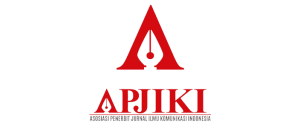Pemaknaan Melalui Konstruksi Sosial Yang Dibangun Oleh Wartawan Dalam Menyebarkan Ujaran Melalui Facebook
DOI:
https://doi.org/10.30656/lontar.v7i1.1566Keywords:
Social Media, Hate Speech, Facebook, Journalist, MeaningAbstract
Social media has an its implications for the democratization of information, because anyonewho owns the account can be a prosumer (producer and consumer) in creating messages,
however the low control mechanisms are still causing the content in social media is not only
positive, but also negative, such as spreading hate speech. Hate speech also coloring the
social media account of journalists in Banten, especially during the Banten election
campaign of Governor in 2017. This research is to uncover the meaning of journalist to the
proffesion and media they manage in utter hatred speech which they spread throuh facebook
in Governor Election of Banten 2017, and it was conducted by qualitative research method
through phenomenology research approach. By using Social Construction Theory as a
framing of qualitative analysis.
References
Berger P.L dan Luckmann T. (2012).
Tafsir Sosial Atas Kenyataan.
Risalah tentang Sosiologi
Pengetahuan (Terjemahan).
Jakarta : LP3ES
Bungin,
Burhan. 2007. Konstruksi Sosial M
edia Massa. Jakarta: Kencana
Prenada Media Group
Djatmika, Prija.2004. Strategi Sukses
Berhubungan Dengan Pers dan
Aspek-Aspek Hukumnya. Malang:
Bayumedia Publishing
Dominick, J. R. & Wimer. (2011). Mass
Media Research : An Introduction
Ninth Edition. Boston : Wadsworth
Cengage Learning
Kuswarno, Engkus. (2009). Fenomenologi
(Konsepsi, Pedoman, dan Contoh
Penelitian). Bandung: Widya
Padjajaran.
Murdiyatmoko, Janu. (2007). Sosiologi,
Mengkaji dan Memahami
Masyarakat.
Bandung :Grafindo Media Pratama
Moustakas, Clark. 1994.
Phenomenological Research Methods.
California : Sage
Publications
Nasrullah, Rulli. (2015). Media Sosial.
Bandung: Simbiosa Rekatama
Solis, Brian. (2012). The Rise Of Digital
Influence. Altimeter Group.
Schutz, Alfred. (1967). The
Phenomenology of the Social World. USA
: Northwestern
University Press
Van Dijck, J. (2006). The Network Society.
California : Sage Publications.
Brison, Susan. (2013). Hate Speech.
Blackwell Publishing Ltd.
Holmberg, S. (2008). Voting Behavior in
US Presidential Elections.
Department of Political Science.
University of Gothenburg.
Journal Independent Journalism Centre.
(2015). Hate Speech. Moldova.
Linda, Martin Alcoff. (2006). Visible
Identities : Race, Gender and The
Self. Oxford University Press.
Mandiberg, Michael. (2012). The Social
Media Reader. New York :
New York University Press.
Matsuda, Mary. J. (1993). Words That
Wound : Critical Race Theory,
Assaultive Speech and The First
Amendment. Boulder: Westview
Press
Meyrowitz, J. (1999). Understanding of
Media. Et Cetera.
Ngangi, Charles R. (2011). Konstruksi
Sosial dalam Realitas Sosial. ASE
jurnal, Vol. 7 No. 2.
Dewan Pers. 2011. Kode Etik Jurnalistik.
Diakses 7 Desember 2017 dari:
http://dewanpers.or.id/peraturan/det
ail/190/kode-etik-jurnalistik
Solis, B. (2012). Social Media is about
Science. Diakses pada 16 Oktober 2016,
dari
http://www.briansolis.com/2012/03
/social-media-is-about-social-science-not
technology/
Kominfo. (2015). Pengguna internet tahun
Diakses pada 15 Oktober 2016,
dari:https://kominfo.go.id/index.ph
p/content/detail/3415/Kominfo+%3A+Pen
gguna+
internet+di+Indonesia+63+Juta+Or
ang/0/berita_satker
Hate speech. (2015). Diakses pada 16
oktober 2016, dari
http://www.bantuanhukum.com/2015/11/15/apa-itu-hatespeech-atau-ucapankebencian
Azzam, Ira. (2014). Warganet. Diakses
pada 16 Oktober 2016, dari
http://www.kompasiana.com/irazza
m/warganet-itu-apa-sih-apa-peran
mereka_56b009b8149773bc10636
e
Houbian, Michael. (n.d). The Net and
Warganets. Diakses 16 November 2016,
dari
http://www.columbia.edu/~rh120/c
h106.x01
Infografis Penetrasi dan Perilaku
Pengguna Internet Indonesia. Asosiasi
Pengguna Jasa
Internet di Indonesia. 2016. (2016).
Diakses 15 April 2017, dari
http://isparmo.web.id/2016/11/21/d
ata-statistik-pengguna-internetindonesia-2016
Tinjauan Psikologis Kebencian.(n.d).
Diakses 15 April 2017, dari
https://www.kabar6.com/aneka/taju
k/29741-menebar-kebencian
Statistik pengguna media sosial.
(n.d).Diakses 15 April 2017, dari
https://id.techinasia.com/talk/statist
ik-pengguna-internet-dan-media-sosialterbaru-diindonesia
Downloads
Published
Issue
Section
License
By submitting an article to the journal, the author(s) agree to transfer the published article's copyright to the journal, which will act as the publisher. This means the journal will have the right to publish the article in various forms, including reprints. The journal will maintain the publishing rights to the published articles.
In line with the license, authors and third parties (readers, researchers, and others) are allowed to share and adapt the material. In addition, the material must be given appropriate credit, provided with a link to the license, and indicated if changes were made. If authors remix, transform, or build upon the material, authors must distribute their contributions under the same license as the original.






